Phosphorus Deficiency
Phosphorus is an essential nutrient that it’s very important during flowering. It also helps with root and stems growth. It allows your plant to perform photosynthesis or convert light into energy. It assists at the beginning of your plant’s life during the germination phase and also is useful during your plant’s reproductive phase.
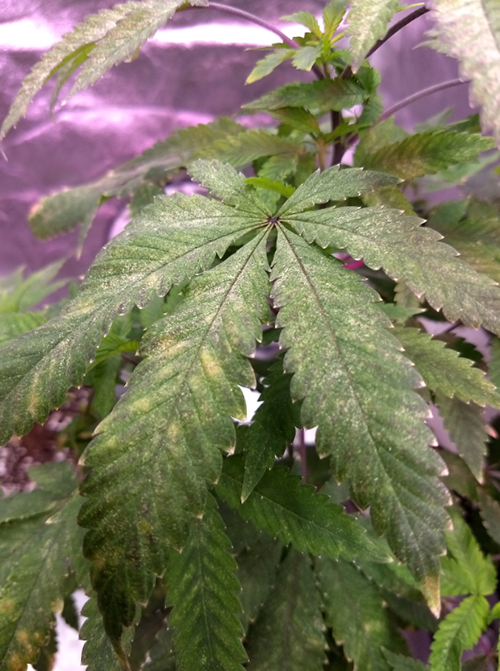
Signs of Phosphorus Deficiency
1. Leaves turn to a blue-green color
2. Lower leaves turn yellow and brown
3. The stem can turn a purple color
4. Leaves have blotches of brown or blue
5.Slow growth
6. Affected leaves start to curl
7. Lower leaves begin to die
Solution
1.Adjust pH to Correct Range
·In soil, phosphorus is best absorbed by the roots in the 6.2 - 7.0 pH
·In hydro, phosphorus is best absorbed by the roots in the 5.5 - 6.2 pH range
2.Make sure the temperature in the right range
Plants are comfortable with the room temperature, when it lower than 60°F (15°C), as well as large temperature swings, can make it harder for the plant to absorb phosphorus, it will cause phosphorus deficiency.
3.Give the Right Nutrients, do not overdose
If you are sure it’s phosphorus deficiency, you can add extra phosphorus to your plants, or you can use nutrients which include phosphorus, but do not over does.
4.Take Good Care of the Roots
Phosphorus deficiency will also cause root problem, proper watering and right PH will help to protect the root system to recover.
Tobacco Mosaic Virus
The tobacco mosaic virus is very fatal for many plants, like tomato, pepper, eggplant, tobacco, spinach... and the virus infection causes light and dark green mottled areas on the leaves. The dark green areas tend to be somewhat thicker than the lighter portions of the leaf. The leaf mottling is seen more easily if the affected plant surface is partially shaded. Stunting of young plants is common and often is accompanied by a distortion and fern-like appearance of the leaves. Older leaves curl downward and may be slightly distorted. Certain strains of the virus can cause a mottling, streaking, and necrosis of the buds. Infected plants are not killed, but they produce poor quality buds and low yields.
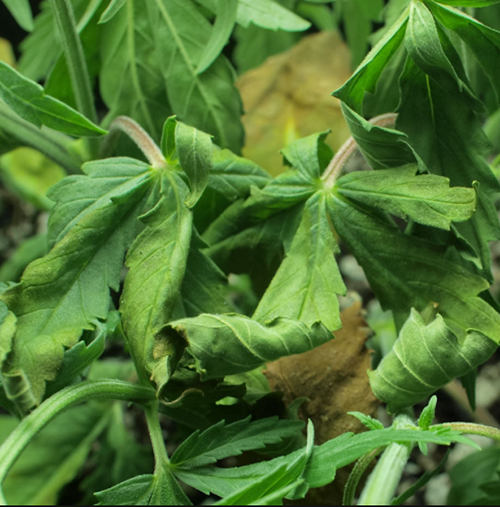
Solution
Virus diseases cannot be controlled once the plant is infected. Therefore, every effort should be made to prevent the introduction of virus diseases into the garden. Sanitation is the primary means of controlling virus diseases. Infected plants should be removed immediately to prevent the spread of the pathogens. The use of tobacco products during cultural practices should be avoided to prevent inoculation of plants with the tobacco mosaic virus. Those people using tobacco or working with infected plant material should wash their hands thoroughly in soapy water before handling your plants.
Spider Mites
Spider mites are not insects but are more closely related to spiders. Most spider mites have the ability to produce a fine silk webbing. They have tiny mouthparts modified for piercing individual plant cells and removing the contents. This results in tiny yellow or white speckles. When many of these feeding spots occur near each other, the foliage takes on a yellow or bronzed cast. Once the foliage of a plant becomes bronzed, it often drops prematurely. Heavily infested plants may be discolored, stunted or even killed. Web producing spider mites may coat the foliage with the fine silk which collects dust and looks dirty.

Solution
Early detection of spider mites, before damage is noticed, is VERY important. The tiny spider mites can be detected only by a full and thorough leaf inspection (on both sides of the leaf). you can use 1 tablespoon of bleach to 1 gallon of 95°F, pH balanced, water in a spray bottle.) or use a miticide with Abamectin or lindane in it. That seems to work best. There are insect predators that can help in providing some control but this does not mean 100% eradication and in a consumable crop that is what we are after. The predator mite can help to control them if chemical sprays are not your thing.
Heat Stress
Plants are very sensitive to temperature, no matter indoor grow or outdoor grow when the temps are so high, low humidity or light too close the plants, the plants will have heat stress problem.
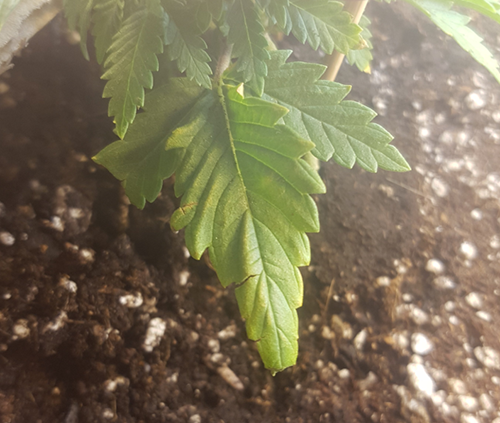
Sign of Heat Stress
Plants leaves will become yellow or brown spot, When the heats get too high, the edges of the serrated leaves will begin to curl up and the leaves will begin to “cup”
Solutions
Buying a temperature monitor to monitor the temps, according to the monitor to adjust the temps to help plants keep in a comfortable environment. For the indoor grow, a good ventilation system is very important, keep the light don’t close to your plants.
Iron Deficiency
Iron is a necessary nutrient that helps plants grow tissues.And iron is needed to help enzymes function well or for chlorophyll to synthesize properly.
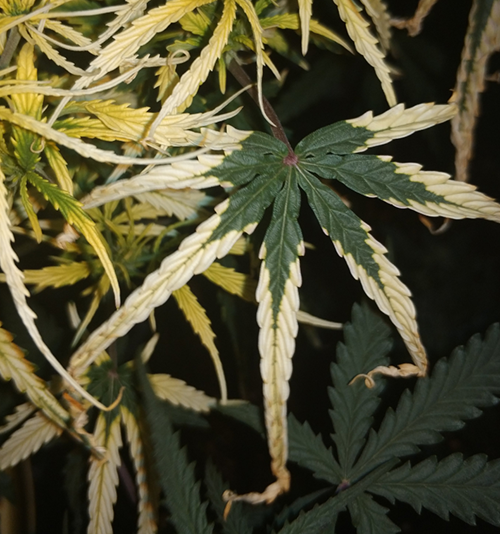
Signs of Iron Deficiency
1.Yellowing outside the veins of the plants' leaf, veins remain green
2.Young leaves show yellow from opposite tips of the leaf
3.Slow growth
4.Bigger leaves will start to yellow between the veins of the leaf
5.Leaves will start to show signs of burnt tips
6.Eventually, the leaf will fall off
7.Thin bud development
Solutions:
1. Adjust pH to Correct Range
·In soil, iron is best absorbed by the roots in the 6.0 - 6.5 pH range
·In coco coir or hydro, iron is best absorbed by the roots in the 5.5 - 6.5 pH range
2.Most plants growers don't need to add more iron in response to an iron deficiency,usually cal-mag supplement contains iron, so do not overdose.
3.Give proper water schedule, do not over water,the root system is important for plants to recover from iron deficiency.
Zinc Deficiency
Zinc is responsible for enzyme function and chlorophyll in the plants, and which affects the strength of all parts of the plant such as the stems, branches, stalks, and leaves.
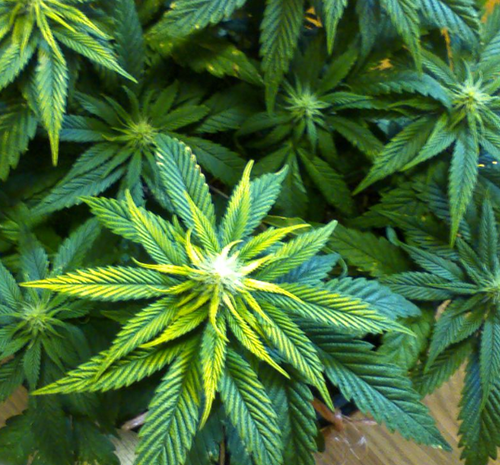
Signs of Zinc Deficiency
1.Yellowing between the veins, in new and young leaves
2.New Leafs are small and thin and appear twisted
3.New leaf growth is pale yellow-green
4.Stems fail to grow and stretch leaving minute leafs
5.The tips of leaves appear burnt
6.Internode spacing is reduced
7.Growth is stunted
8.Buds are thin and light to the touch
9.During flowering, buds will start to twist
10.End yields are small
Solutions:
1.Adjust pH to Correct Range
·In soil, zinc is best absorbed by the roots in the 6.0 - 6.5 pH
·In hydro, zinc is best absorbed by the roots in the 5.5 - 6.0 pH
2.Give the Right Nutrients, not overdose
3.Take Good Care of the Roots, make sure proper watering system will help plants grow healthy and avoid a host of problems.
Magnesium Deficiency
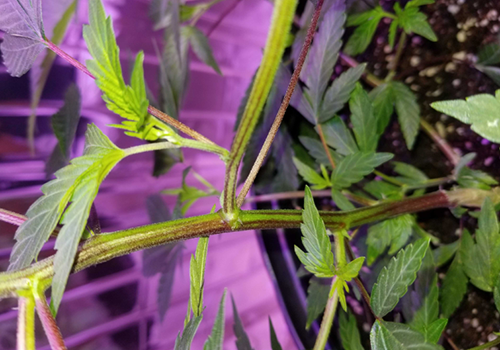
Magnesium is a mobile element, Magnesium deficiency usually starts in the middle of the plant and spreads to the younger leaves. Leaves turning yellow, or even white, with the veins remaining dark green, is the best indicator of Mag deficiency.Magnesium can be easily absorbed by plants when the PH range of is 5.0-7.0, also other factors may reduce or lock-out the mag uptake, such as a permanent humidity, low temperatures, or acid and cold substrates.
Solution:
As Calcium, magnesium deficiency usually appear together, so usually get a Cal-Mag supplement
1.Adjust the PH level:
·In soil, magnesium is best absorbed by the roots in the 6.0 - 7.0
·In hydro, magnesium is best absorbed by the roots in the 6.0 - 6.5 pH range
2.Adding more magnesium to your growing system, but not overdone,otherwise will also got trouble.
3.Flush your system with clean, pH'd water that contains a regular dose of plant-friendly nutrients that includes magnesium. Such as: spray with a 2 percent Epsom salt.
Calcium Deficiency
Phosphorus is an essential nutrient that it’s very important during flowering. It also helps with root and stems growth. It allows your plant to perform photosynthesis or convert light into energy. It assists at the beginning of your plant’s life during the germination phase and also is useful during your plant’s reproductive phase.

Signs of Phosphorus Deficiency
1. Leaves turn to a blue-green color
2. Lower leaves turn yellow and brown
3. The stem can turn a purple color
4. Leaves have blotches of brown or blue
5.Slow growth
6. Affected leaves start to curl
7. Lower leaves begin to die
Solution
1.Adjust pH to Correct Range
·In soil, phosphorus is best absorbed by the roots in the 6.2 - 7.0 pH
·In hydro, phosphorus is best absorbed by the roots in the 5.5 - 6.2 pH range
2.Make sure the temperature in the right range
Plants are comfortable with the room temperature, when it lower than 60°F (15°C), as well as large temperature swings, can make it harder for the plant to absorb phosphorus, it will cause phosphorus deficiency.
3.Give the Right Nutrients, do not overdose
If you are sure it’s phosphorus deficiency, you can add extra phosphorus to your plants, or you can use nutrients which include phosphorus, but do not over does.
4.Take Good Care of the Roots
Phosphorus deficiency will also cause root problem, proper watering and right PH will help to protect the root system to recover.
Tobacco Mosaic Virus
The tobacco mosaic virus is very fatal for many plants, like tomato, pepper, eggplant, tobacco, spinach... and the virus infection causes light and dark green mottled areas on the leaves. The dark green areas tend to be somewhat thicker than the lighter portions of the leaf. The leaf mottling is seen more easily if the affected plant surface is partially shaded. Stunting of young plants is common and often is accompanied by a distortion and fern-like appearance of the leaves. Older leaves curl downward and may be slightly distorted. Certain strains of the virus can cause a mottling, streaking, and necrosis of the buds. Infected plants are not killed, but they produce poor quality buds and low yields.

Solution
Virus diseases cannot be controlled once the plant is infected. Therefore, every effort should be made to prevent the introduction of virus diseases into the garden. Sanitation is the primary means of controlling virus diseases. Infected plants should be removed immediately to prevent the spread of the pathogens. The use of tobacco products during cultural practices should be avoided to prevent inoculation of plants with the tobacco mosaic virus. Those people using tobacco or working with infected plant material should wash their hands thoroughly in soapy water before handling your plants.
Spider Mites
Spider mites are not insects but are more closely related to spiders. Most spider mites have the ability to produce a fine silk webbing. They have tiny mouthparts modified for piercing individual plant cells and removing the contents. This results in tiny yellow or white speckles. When many of these feeding spots occur near each other, the foliage takes on a yellow or bronzed cast. Once the foliage of a plant becomes bronzed, it often drops prematurely. Heavily infested plants may be discolored, stunted or even killed. Web producing spider mites may coat the foliage with the fine silk which collects dust and looks dirty.

Solution
Early detection of spider mites, before damage is noticed, is VERY important. The tiny spider mites can be detected only by a full and thorough leaf inspection (on both sides of the leaf). you can use 1 tablespoon of bleach to 1 gallon of 95°F, pH balanced, water in a spray bottle.) or use a miticide with Abamectin or lindane in it. That seems to work best. There are insect predators that can help in providing some control but this does not mean 100% eradication and in a consumable crop that is what we are after. The predator mite can help to control them if chemical sprays are not your thing.
Heat Stress
Plants are very sensitive to temperature, no matter indoor grow or outdoor grow when the temps are so high, low humidity or light too close the plants, the plants will have heat stress problem.

Sign of Heat Stress
Plants leaves will become yellow or brown spot, When the heats get too high, the edges of the serrated leaves will begin to curl up and the leaves will begin to “cup”
Solutions
Buying a temperature monitor to monitor the temps, according to the monitor to adjust the temps to help plants keep in a comfortable environment. For the indoor grow, a good ventilation system is very important, keep the light don’t close to your plants.
Iron Deficiency
Iron is a necessary nutrient that helps plants grow tissues.And iron is needed to help enzymes function well or for chlorophyll to synthesize properly.

Signs of Iron Deficiency
1.Yellowing outside the veins of the plants' leaf, veins remain green
2.Young leaves show yellow from opposite tips of the leaf
3.Slow growth
4.Bigger leaves will start to yellow between the veins of the leaf
5.Leaves will start to show signs of burnt tips
6.Eventually, the leaf will fall off
7.Thin bud development
Solutions:
1. Adjust pH to Correct Range
·In soil, iron is best absorbed by the roots in the 6.0 - 6.5 pH range
·In coco coir or hydro, iron is best absorbed by the roots in the 5.5 - 6.5 pH range
2.Most plants growers don't need to add more iron in response to an iron deficiency,usually cal-mag supplement contains iron, so do not overdose.
3.Give proper water schedule, do not over water,the root system is important for plants to recover from iron deficiency.
Zinc Deficiency
Zinc is responsible for enzyme function and chlorophyll in the plants, and which affects the strength of all parts of the plant such as the stems, branches, stalks, and leaves.

Signs of Zinc Deficiency
1.Yellowing between the veins, in new and young leaves
2.New Leafs are small and thin and appear twisted
3.New leaf growth is pale yellow-green
4.Stems fail to grow and stretch leaving minute leafs
5.The tips of leaves appear burnt
6.Internode spacing is reduced
7.Growth is stunted
8.Buds are thin and light to the touch
9.During flowering, buds will start to twist
10.End yields are small
Solutions:
1.Adjust pH to Correct Range
·In soil, zinc is best absorbed by the roots in the 6.0 - 6.5 pH
·In hydro, zinc is best absorbed by the roots in the 5.5 - 6.0 pH
2.Give the Right Nutrients, not overdose
3.Take Good Care of the Roots, make sure proper watering system will help plants grow healthy and avoid a host of problems.
Magnesium Deficiency

Magnesium is a mobile element, Magnesium deficiency usually starts in the middle of the plant and spreads to the younger leaves. Leaves turning yellow, or even white, with the veins remaining dark green, is the best indicator of Mag deficiency.Magnesium can be easily absorbed by plants when the PH range of is 5.0-7.0, also other factors may reduce or lock-out the mag uptake, such as a permanent humidity, low temperatures, or acid and cold substrates.
Solution:
As Calcium, magnesium deficiency usually appear together, so usually get a Cal-Mag supplement
1.Adjust the PH level:
·In soil, magnesium is best absorbed by the roots in the 6.0 - 7.0
·In hydro, magnesium is best absorbed by the roots in the 6.0 - 6.5 pH range
2.Adding more magnesium to your growing system, but not overdone,otherwise will also got trouble.
3.Flush your system with clean, pH'd water that contains a regular dose of plant-friendly nutrients that includes magnesium. Such as: spray with a 2 percent Epsom salt.
Calcium Deficiency
Calcium is important for the plant's growth, it helps provide structure to the plant, especially under LED growing.
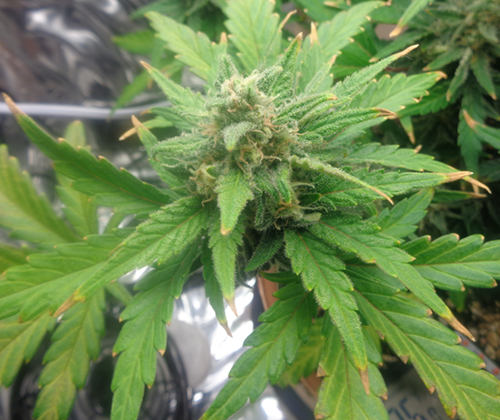
Signs of Calcium Deficiency
1.Upper leaf issues show spotting first
2.Lower leaves curl and twist
3.Yellow, brown spots appear on leaf and tips
4.Stunted growth
5.Flower development is slow
6.Brown or dark spots on leaves
7.The random pattern of spots
8.Stems start to become weak
9.Roots become weak or begin to die
Solution:
Correct the PH level for your growth.Soil, 6.0 - 7.0 pH range. Hydro or coco coir, 5.5 - 6.5 pH range.
Add extra calcium, some growers use tap water with great success! Most tap water contains calcium and magnesium in small quantities.
You may be interested in the following article:
《The Wasted Carton Recycling Use,Make A Small Greenhouse Now!》
《How To Effectively Improve Seed Germination Rate?》
《The Problems In Greenhouse And How To Solve Them》

Signs of Calcium Deficiency
1.Upper leaf issues show spotting first
2.Lower leaves curl and twist
3.Yellow, brown spots appear on leaf and tips
4.Stunted growth
5.Flower development is slow
6.Brown or dark spots on leaves
7.The random pattern of spots
8.Stems start to become weak
9.Roots become weak or begin to die
Solution:
Correct the PH level for your growth.Soil, 6.0 - 7.0 pH range. Hydro or coco coir, 5.5 - 6.5 pH range.
Add extra calcium, some growers use tap water with great success! Most tap water contains calcium and magnesium in small quantities.
You may be interested in the following article:
《The Wasted Carton Recycling Use,Make A Small Greenhouse Now!》
《How To Effectively Improve Seed Germination Rate?》
《The Problems In Greenhouse And How To Solve Them》
没有评论:
发表评论